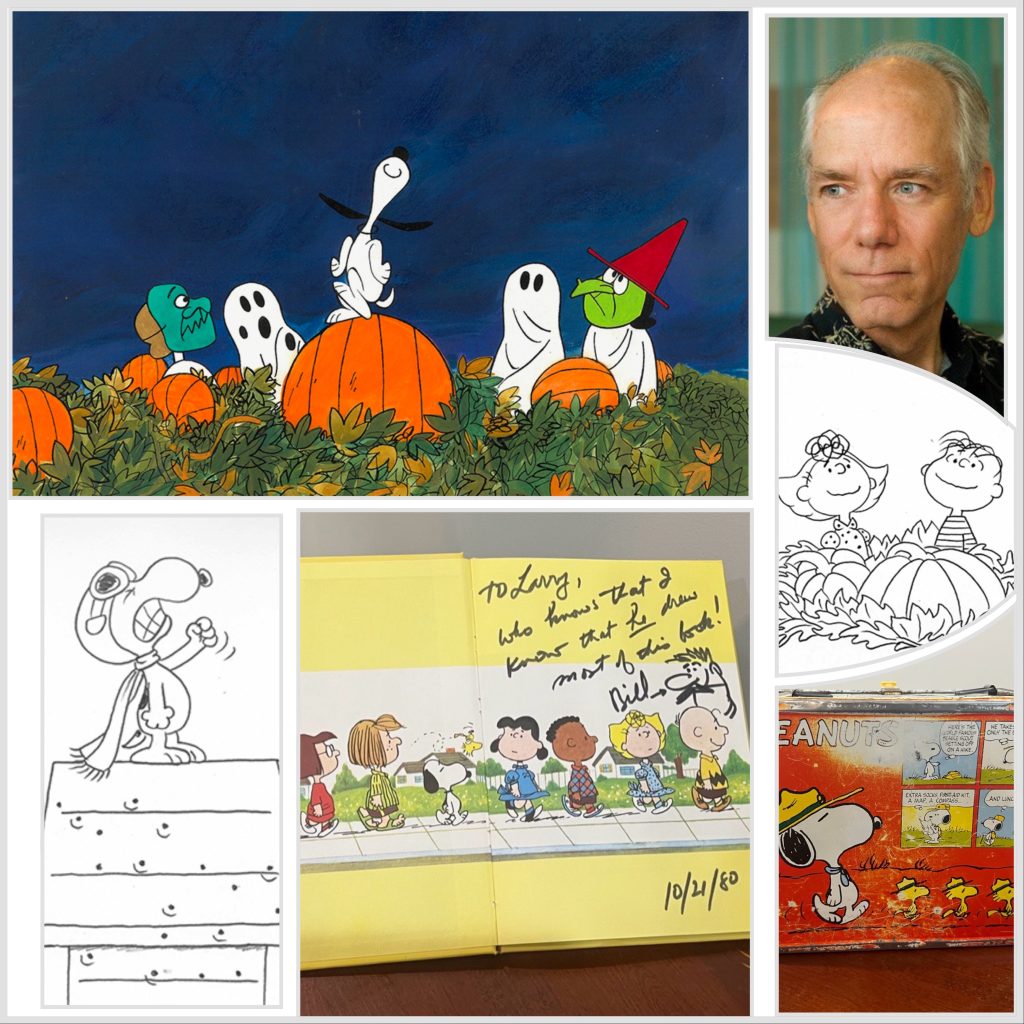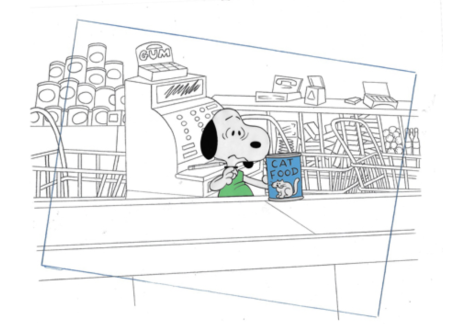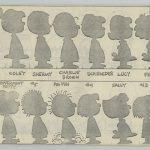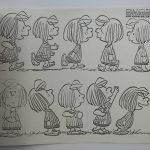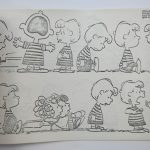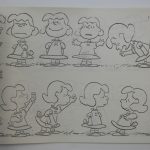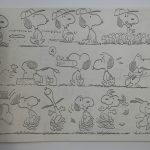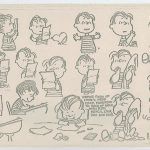As part of our Peanuts art special event, “Halloween in August” featuring the new limited edition The Great Pumpkin, award-winning animation director and artist Larry Leichliter added layout drawings to original vintage cels that needed context.
Here’s one example:
He is also creating original drawings based on two images from It’s The Great Pumpkin, Charlie Brown for folks who buy art during our event, which includes the new limited edition, The Great Pumpkin.
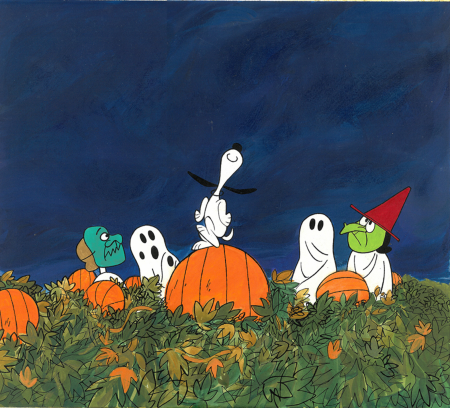
The limited is based on the cover by Ed Levitt for a storybook created in conjunction with the release of It’s The Great Pumpkin, Charlie Brown. (You can read more about Ed on our blog about him HERE.
We at ArtInsights went through the whole movie in order to pick one great image that would inspire him and he could use, but we sent him about a dozen screen caps, and it was so hard for him to choose, he wound up choosing two, both of which are wonderful….
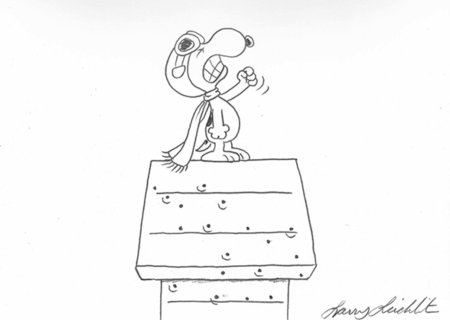
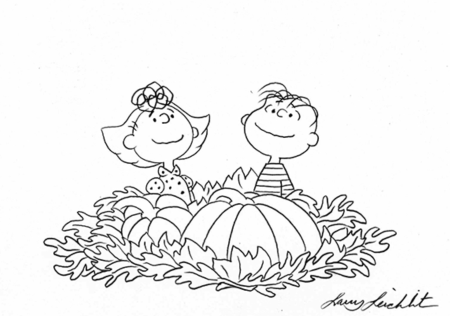
These images are then the basis for original drawings created for collectors who buy art during our show, given as a special gift. (Only one per household, and only until September 2nd. We don’t want to take advantage of his kindness or have him doing this forever!)
We caught up with Larry and talked to him about his experience as an artistic kid in LA, his memories of Halloween and It’s the Great Pumpkin, Charlie Brown specifically, and what inspired him most during his years working with Bill Melendez and company, and animating at Bill Melendez Studios, where the Peanuts cartoons were made.
Did you see animated features as a kid?
Larry Leichliter: I think I remember seeing Bambi or Pinocchio at the movie theater. I always liked to draw as a kid, and the Disney films in particular inspired me to draw. I remember I also used to draw the characters from Lady and the Tramp a lot. Copying characters from those cartoons represented my early attempts at outlines, but it wasn’t until much later, though, that I actually learned how to draw. In school, whether it’s life drawing or cartoons, you understand you’re drawing volumes and forms first, to get proportions, and then you do the details.
Did you learn squash and stretch from classes or from watching cartoons?
It’s one of the first things you learn, and I don’t even remember where I first heard the terms and learn the concept, but I do remember as a kid, making flip books. The first kind of flip book that I made was, you take a pencil, and you roll up a piece of paper on the pencil, then you could make a drawing on the piece of paper underneath, and pull the pencil down and unroll the paper that you had rolled up on the pencil, and make another drawing, and you can run the pencil up and down, and paper would curl up on the pencil, and you could make those two drawings animate. That was my first foray into animation.
You’ve always had a love of Peanuts, and you even have proof from your own career…
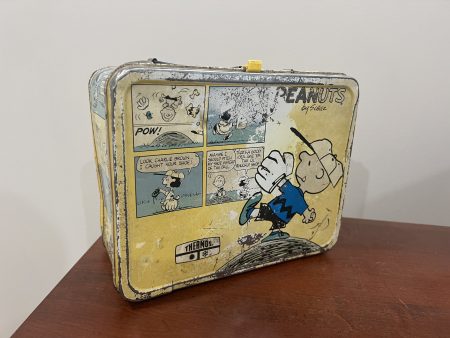
I do! This is the lunchbox that I took to work every day, no matter where I worked, whether it was a Disney or Warner Brothers or any other studio, but a friend of my wife’s gave this to her, it was her son’s, and he gave it to her because he knew that I worked on Peanuts cartoons, and from that point on, in fact, even while I was working at Melendez Studios, I would take my lunch to work in that lunchbox every day, so people got to know me is the Peanuts guy.
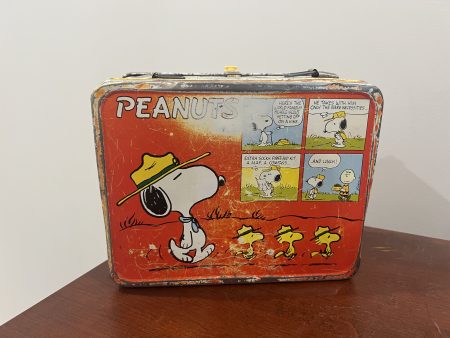
How much do you refer to Schultz’s drawings, and how much to the earlier Melendez cartoons, in terms of creating Snoopy and other Peanuts characters on-model? firstly, when you were working on the cartoons, and secondly, for the layouts that you do now, as part of the limited editions?
Schultz is always my first reference, because I can’t say enough about his sense of design, and how ideal these characters are, in terms of their design. They’re simple, and yet very expressive, and in some ways, easy to draw, but in other ways, you have to pay attention, so I do refer to his drawings frequently. There was a fellow who worked for Bill in the early days, his name was Frank Smith, and he did the original model sheets for the studio. I use the copy I have of his model sheets all the time. They sit on my desk.
You have that for every character? I’d love to have that, as would every collector, I’m sure!
Yeah, they have all poses of the different characters. I have the first model sheet I received when I started working there back in 1970, and it’s something I’ve kept the entire time, because it’s such a great model sheet. The drawings look so much like Schultz’s drawings. They’re just really well-drawn, and that was Frank Smith. The other thing I do, when I get a cel or drawing that needs a flesh-out out background or a layout, I’ll go and look at the film, and then I’ll look at the original artwork produced by the studio to try and recreate what it actually looked like in the film, using the original art as reference, as well as whatever other information I can gather from research. That’s how I put layouts or the look of limited editions together.
Can you name any mentors that were helpful when you worked for Bill Melendez?
First and foremost, I’d say Al Pabian. He was a wonderful guy. I started at the studio as an assistant animator, and Al was the lead assistant animator, so sharing an office with him was a real opportunity for me, because he gave me a lot of the introductory information that I needed to get a handle on how to draw the characters and what to look out for and stuff like that. Beyond that, I’d have to say Don Lusk, although he only worked at the studio a few years. He had the office right next to mine. We were actually situated in houses. There were three houses on Larchmont Boulevard. Al Pabian and I had a bedroom in the back with a window that looked out on the backyard, which was paved, and we use for a parking lot. I remember, there were two bathrooms, maybe three or four bedrooms, and a kitchen.
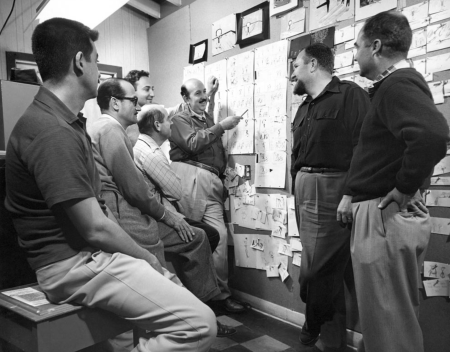
Don Lusk had his office to himself in another bedroom, right next to ours, and I could go in and chat with him every once in a while. One of the things he told me when we were talking about animation was that he liked, when he started a scene, he would think about how to motivate the character, and what was going to get the thing moving. He said, “I like to throw the character off balance, and then see what he does.” When I look at his scenes, there’s a lot of movement in them, because the character is always off balance and trying to regain his balance in some way. It may not be really slapstick, although many times it was, sometimes it was just emotional, but the movement, the characters being out of balance, was always part of what he would do. That turned out to be essential, and an interesting introduction to me for how to begin animating.
When you create a layout behind a production cel to give it context, how do you go about that without being too distracting? I’m thinking of the scene with Snoopy in the supermarket, during the Joe Cool sequence in There’s No Time for Love, Charlie Brown.
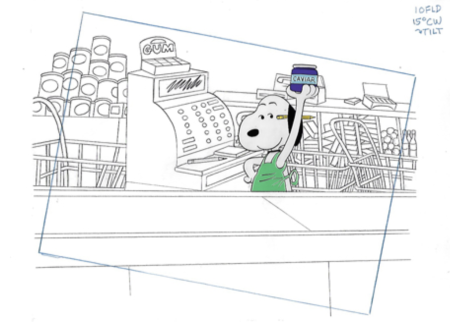
Like you say, you don’t want the background or other elements in the background to be so interesting that they distract you from the main character, or what the action is in in the scene. The great thing about the design of the show, and again, this goes back to Schultz and how he inspired all of the artists that work on the show, is that the style of drawing throughout the specials is usually very clean and simple, sometimes even stylized. A circle will not be a true circle, it’ll be this kind of oval. A box will not be a straight square box, it’ll be somewhat off. So that scene that you’re talking about in the grocery store, there were all these grocery carts and there’s a lot of cross-hatching going on, but there is a way to do it where you get the pattern, and it’s fairly detailed, but it’s not overly distracting.
What do you remember, yourself, about the Halloween special?
When the Christmas special came out, I was in high school already, and we looked forward to it with great anticipation. My brother and sister and I all sat down in front of the television and watched it. When the Halloween special came out, I didn’t know about it ahead of time, so I went to school the next day, and everybody was talking about it, and all the great scenes with Snoopy fighting the Red Baron, and the trick or treating, and I was like Charlie Brown, like I got a rock. I had missed it. So I never missed it after that, the next year and every year following, because, you know, we were all big fans of the Peanuts books. I still have several of them from back then that I keep on my office shelf.
Did you love horror movies and watch them? If so, what was the first one?
Oh definitely. It’s hard to remember which one I saw first, but I remember seeing and loving The Blob, with Steve McQueen, and The Night of the Living Dead, which is a great movie and still a favorite, but that was later in the 60s.
I love that horror movies offer an opportunity for the writer and director to speak to subjects with societal importance and can make social commentary, which is true for both The Night of the Living Dead and Invasion of the Body Snatchers, but also so many others, but that’s also true in the case for Schulz’s Peanuts comic strips. They have that in common.
Yeah, that’s one of the best things about both. I grew up in Los Angeles, and a lot of those old B movies were made at various locations in LA, but one of the most popular was Griffith Park. And you’re mentioning Invasion of the Body Snatchers. There was a set of caves up in the hills in in Griffith Park, that you could just walk up a slight hill and come to. It was big and went all the way through this small hill, and opened up into sort of a natural amphitheater. It was it was an interesting place to play, which I did a lot, and that cave is in Invasion of the Body Snatchers.
You actually have a connection to It’s The Great Pumpkin, Charlie Brown as an artist.
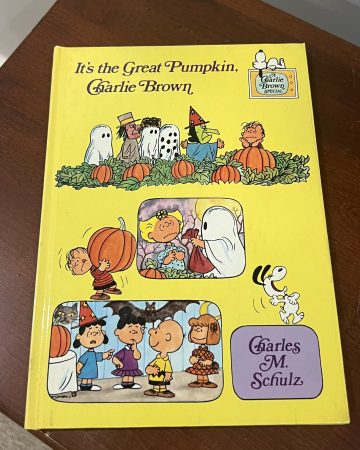
Yes! One of the first chances that I had to work on Snoopy as the flying ace and so many other Peanuts characters at Halloween was this book of It’s Great Pumpkin, Charlie Brown from the 70s. I drew most of the drawings in it based on the film. Doing these images really took me back to the many times I watched the cartoon.
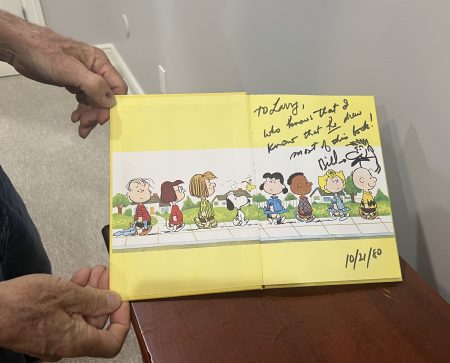
What came up?
Well, I was reminded of one of my favorite moments, which is when Sally says, “”Are you sure it’s legal? I wouldn’t want to get accused of taking part in a rumble.” Sally has so many great lines in that cartoon.
Things like this didn’t occur to me until later, watching the show, but there’s this conversation between Sally and Linus in the pumpkin patch that I’m in love with, because the animator who worked on it and the kids who did the voices, they were just so in sync with each other. The acting by the kid who played Sally, and the simple, subtle gestures with her head and with her looks to the side fit so well with the attitude in the dialogue. I asked Bill one day, “Who animated that scene?”, and he said it was Ruth Kissane, who was, I think, the only female animator at the studio in those days, and it’s just wonderful.
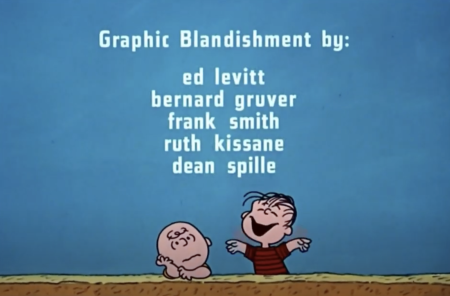
My favorite line was “If anyone had told me I’d be waiting in a pumpkin patch on Halloween night I’d have said they were crazy.”
What do you tell kids or people going into animation in terms of advice?
I never did well in interviews. Somebody would recommend me for a job, so they’d call me in, I’d go in, and have an interview, and I wouldn’t get the job because I was so bad in interviews. But the fact that somebody I worked with thought enough of my work and of me to recommend me made all the difference. It opened up a lot of opportunities for me. So what I tell people when I’m teaching classes is to be sure and make friends. Get to know the people that you’re working with. I don’t think people really need to be advised of that, because for most folks it’s something that just comes naturally, but artists can be reserved. If you’re shy, like I am, and tend to keep to yourself, try to break out of that. Try to get to know people. That’s what’s really going to help you along.
You can read more about the new limited edition “The Great Pumpkin”, or buy it (and, for a limited time, get an original drawing by Larry Leichliter!) by clicking on the image below:
To finish off our blog and interview, here’s a video of Larry showing us all how to draw Snoopy doing his happy dance:

